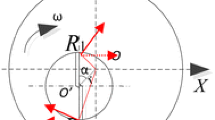Abstract
This paper presents a mechanistic model for micro-drilling cutting forces that includes the cutting edge radius and the minimum chip thickness size effects. The proposed model considers three different cutting regions, i.e., ploughing-dominant, transition, and shearing-dominant, based on these size effects. Specific normal force and specific friction force coefficients have been determined through model calibration using micro-drilling experimental results. Model is validated with micro-drilling experimental results of different cutting conditions and of different machining environments. Comparisons of model simulated and experimental results show that ploughing force contributions are significant, especially at low feed rates. The proposed model has also been applied to characterize size effects in micro-drilling.
Similar content being viewed by others
References
Rahamathullah I, Shunmugam MS (2013) Analyses of forces and hole quality in micro-drilling of carbon fabric laminate composites. J Comput Math 47(9):1129–1140
Kuar AS, Acherjee B, Ganguly D, Mitra S (2012) Optimization of Nd:yag laser parameters for microdrilling of alumina with multi quality characteristics via grey–taguchi method. Mater Manuf Process 27:329–336
Liow JL (2009) Mechanical micromachining: a sustainable micro-device manufacturing approach? J Clean Prod 17:662–667
Bissacco G, Hansen HN, Slunsky J (2008) Modelling the cutting edge radius size effect for force prediction in micro milling. CIRP Ann Manuf Technol 57:113–116
Aramcharoen A, Mativenga PT (2009) Size effect and tool geometry in micromilling of tool steel. Precis Eng 33:402–407
Vollertsen F, Biermann D, Hansen HN, Jawahir IS, Kuzman K (2009) Size effects in manufacturing of metallic components. CIRP Ann Manuf Technol 58:566–587
Chae J, Park SS, Freiheit T (2006) Investigation of micro-cutting operations. Int J Mach Tools Manuf 46:313–332
Klocke F, Gerschwiler K, Abouridouane M (2009) Size effects of micro drilling in steel. Prod Eng Res Devel 3:69–72
Anand RS, Patra K, Steiner M (2014) Size effects in micro drilling of carbon fiber reinforced plastic composite. Prod Eng Res Devel 8(3):301–307
Liu X, DeVor RE, Kapoor SG, Ehmann KF (2004) The mechanics of machining at the micro scale: assessment of the current state of the science. J Manuf Sci Eng 126:666–678
Anand RS, Patra K (2014) Modeling and simulation of mechanical micro-machining—a review. Mach Sci Technol 18:323–347
Rao S, Shunmugam MS (2012) Analytical modeling of micro end-milling forces with edge radius and material strengthening effects. Mach Sci Technol 16(2):205–227
Lai X, Li H, Li C, Lin Z, Jun N (2008) Modeling and analysis of micro scale milling considering size effect, micro cutter edge radius and minimum chip thickness. Int J Mach Tools Manuf 48:1–14
Jun MBG, Goo C, Malekian M, Park S (2012) A new mechanistic approach for micro end milling force modeling. J Manuf Sci Eng 134:1–97
Malekian M, Park SS, Jun MBG (2009) Modeling of dynamic micro-milling cutting forces. Int J Mach Tools Manuf 49:586–598
Hinds BK, Treanor GM (2000) Analysis of stresses in micro-drills using the finite element method. Int J Mach Tools Manuf 40:1443–1456
Gong Y, Lin C, Ehmann KF (2005) Dynamics of initial penetration in drilling: part 1—mechanistic model for dynamic forces. J Manuf Sci Eng 127:280–288
Sambhav K, Tandon P, Kapoor SG, Dhande SG (2013) Mathematical modeling of cutting forces in microdrilling. J Manuf Sci Eng 135:014501
Kim DW, Lee YS, Park MS, Chu CN (2009) Tool life improvement by peck drilling and thrust force monitoring during deep-micro-hole drilling of steel. Int J Mach Tools Manuf 49:246–255
Zhang H, Wang X, Pang S (2014) A mathematical modeling to predict the cutting forces in microdrilling. Math Probl Eng, Article ID 543298, 11p
Rahamathullah I, Shunmugam MS (2014) Mechanistic approach for prediction of forces in micro-drilling of plain and glass-reinforced epoxy sheets. Int J Adv Manuf Technol 75:1177–1187
Flachs JR, Salahshoor M, Melkote SN (2014) Mechanistic models of thrust force and torque in step-drilling of Al7075-T651. Prod Eng Res Devel 8:319–333
Shaw MC (1992) Metal cutting principles, 1st Indian Edition, CBS Publ Distr. 428–486
Elhachimi M, Torbaty S, Joyot P (1999) Mechanical modelling of high speed drilling 1: predicting torque and thrust. Int J Mach Tools Manuf 39:553–568
Mauch CA, Lauderbaugh LK (1990) Modeling the drilling processes—an analytical model to predict thrust force and torque. Proc Comput Model Simul Manuf Process 48:59–65
Yuan ZJ, Zhou M, Dong S (1996) Effect of diamond tool sharpness on minimum cutting thickness and cutting surface integrity in ultraprecision machining. J Mater Process Technol 62:327–330
Liu X, DeVor RE, Kapoor SG (2006) An analytical model for the prediction of minimum chip thickness in micromachining. J Manuf Sci Eng 128:474–481
Patra K, Anand RS, Steiner M, Biermann D (2015) Experimental analysis of cutting forces in microdrilling of austenitic stainless steel (X5CrNi18-10). Mater Manuf Process 2:248–255
Zheng L, Wang C, Yang L, Song Y, Fu L (2012) Characteristics of chip formation in the micro-drilling of multi-material sheets. Int J Mach Tools Manuf 52:40–49
Biermann D, Kirschner M, Eberhardt D (2014) A novel method for chip formation analyses in deep hole drilling with small diameters. Prod Eng Res Devel 8:491–497
Author information
Authors and Affiliations
Corresponding author
Ethics declarations
All professional ethics have been followed. The manuscript has not been submitted to other journal for simultaneous consideration. The manuscript has not been published previously (partly or in full). No data has been fabricated or manipulated and no data, text, or theories by others are presented as if they were the author’s own. Proper acknowledgements to other works have been given. Consent to submit has been received explicitly from all co-authors. Authors whose names appear on the submission have contributed sufficiently to the scientific work and therefore share collective responsibility and accountability for the results.
Conflict of interest
There is no conflict of interest in this work.
Human and animal rights and informed consent
This research does not involve any human or animal participant.
Rights and permissions
About this article
Cite this article
Anand, R.S., Patra, K., Steiner, M. et al. Mechanistic modeling of micro-drilling cutting forces. Int J Adv Manuf Technol 88, 241–254 (2017). https://doi.org/10.1007/s00170-016-8632-2
Received:
Accepted:
Published:
Issue Date:
DOI: https://doi.org/10.1007/s00170-016-8632-2



